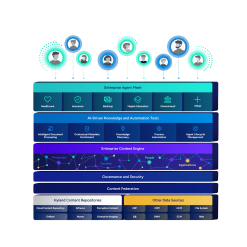Why choose Hyland?
Hyland’s modern content solution platform is cloud-native and built from the ground up to enable extensibility and integration. Our low-code interfaces and solutions provide a rapid time to value and enable developers to build more quickly than ever before.
Our thriving ecosystem of professional services, partners and systems-integrator networks are ready to help modernize your content management strategy so your employees can focus on high-value tasks.
Hyland platform benefits
Hyland customers benefit from our market-leading technology, which constantly evolves and reflects future-forward thinking.
Cloud-native content solution architecture
Gain flexibility and take full advantage of leading cloud providers, including Amazon Web Services (AWS) and Microsoft Azure.
Reduced IT complexity
Hyland’s modern, lightweight solutions leverage low-code tooling and the cloud to make it simpler to build on your technology foundations.
Content intelligence
Unlock the full potential of your enterprise content — whether it’s in structured or unstructured formats — with Hyland’s suite of content intelligence tools. From content enrichment to building your own intelligent agentic workforce, our AI-powered platform reimagines what intelligent content management looks like.
> Learn more | The Hyland tools that are redefining content management with AI
Intelligent process automation
Accelerate your business processes, reduce errors and costs, and automate workflows that don’t require a human touch using AI-enabled process automation, intelligent capture, intelligent document processing and robotic process automation.
Modern application development tools
Use Hyland’s low-code tools and AI-enabled process design automation suite to provide the agility to create compelling user experiences faster than legacy ECM.

















